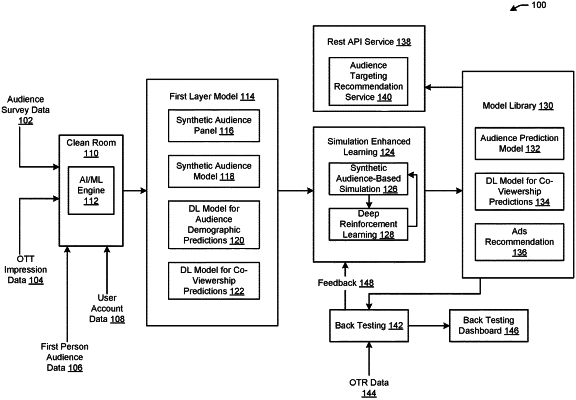| CPC H04N 21/252 (2013.01) [H04N 21/25883 (2013.01); H04N 21/26241 (2013.01); H04N 21/812 (2013.01)] | 20 Claims |

|
1. A method for audience targeting across multiple content mediums, the method comprising:
receiving, by at least one processor of a system, over-the-top (OTT) advertisement impression data comprising metadata and content of advertisement bid requests, the metadata indicative of scheduled OTT media presentation;
receiving, by the at least one processor, survey data indicative of day-part times when television viewers watch content;
determining, by the at least one processor, a number of non-overlapping demographic groups comprising age ranges;
generating, by the at least one processor, based on the OTT advertisement impression data as inputs to a first machine learning model, a first demographic probability vector, wherein each entry of the first demographic probability vector is indicative of a first probability that an OTT viewer is in a respective age range of the non-overlapping demographic groups;
generating, by the at least one processor, based on the survey data as inputs to the first machine learning model, a second demographic probability vector, wherein each entry of the second demographic probability vector is indicative of a second probability that a television viewer is in a respective age range of the non-overlapping demographic groups;
generating, by the at least one processor, based on a combination of the first demographic probability vector and the second demographic probability vector, using the first machine learning model, a third demographic probability vector for the OTT advertisement impression data and the survey data, wherein each entry of the third demographic probability vector is indicative of a third probability that a viewer is in a respective age range of the non-overlapping demographic groups and wherein the third probability is a cross-channel probability for both OTT and television;
generating, by the at least one processor, using the first machine learning model, without deterministic identities of the viewers represented by the third demographic probability vector, an audience recognition model comprising the third demographic probability vector;
generating, by the at least one processor, based on the OTT advertisement impression data and the survey data as inputs to a second machine learning model, a synthetic audience model predicting future advertisement viewing behavior associated with multiple viewers including the viewer;
generating, by the at least one processor, based on the audience recognition model and the synthetic audience model as inputs to a third machine learning model, an assignment of an advertisement bid to a respective demographic group of the non-overlapping demographic groups; and
generating, by the at least one processor, based on the assignment, a ranked list of target demographic groups of the non-overlapping demographic groups for a bid request associated with the advertisement bid.
|